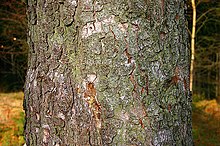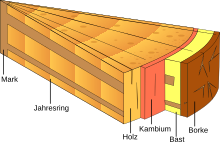bark


The bark is the outermost layer of bark on most trees . It arises from the cork and dead parts of the bast . The bark protects the underlying layers of the tree trunk from physical influences such as temperature, rain, wind, sun, fire and mechanical influences and it serves as a defense against pests and infections .
etymology
The word came from Low German into High German and probably belongs in the sense of “rough, cracked” to an extension of the idg. Bhar- “tip, sting, bristle” (cf. perch ). The term is part of the Swadesh list .
Formation of the bark
The primary finishing fabric
First, the epidermis is the closing tissue in the primary construction of the shoot axis . However, since the epidermis is a permanent tissue, i.e. its cells cannot divide, it tears open through the process of secondary growth in thickness and the plant has to form a secondary tissue, the periderm .
The secondary finishing tissue
In order to replace the function of the decrepit epidermis, the plant first reembryonalizes cortex cells (this means that they are able to divide again). The resulting secondary meristematic, few-row cell layer is called phellogen . This gives off phelloderm on the inside and cork (phellem) on the outside . In some trees, this periderm (surface periderm, periderm = phellogen + phelloderm + phellem) - the bark - remains intact for a very long time, or even for its entire life. Here, lenticels are often installed as ventilation organs. Examples of trees with a secondary finishing fabric are the beech and hornbeam .
Injuries in the bark grow together over time and, unlike in the bark, are still recognizable after decades.
The tertiary final fabric - the bark
In many other trees, on the other hand, the phellogen cannot compensate for the strong growth in thickness through lateral growth and tears open itself. This renewed tear in the final fabric causes a renewed drawing in of a periderm (inner periderm). The parts of the bast cut off in this way die off and together with the cut, old periderm form the bark, which grows continuously due to the dividing activity of the phellogus on one side and the drawing in of more and more periderms.
Different shapes of the finishing fabric of trees
Striped bark on the giant tree of life
Mesh bark on English oak
Ring cork on birch trees
Scaly bark on the common pine
Leaved scaly bark on a maple- leaved plane tree
There are three types of bark of trees with a deep periderm (bark - tertiary finishing fabric):
- Striped bark (e.g. tree of life - Thuja plicata ). With this, cork cambia are newly formed in closed circles running all around. As a result of the widening of the circumference, the bark tears in places and strips are formed which run in a vertical direction.
- Scale bark / plate bark (e.g. sycamore maple - Acer pseudoplatanus ). The scaly bark is characteristic of most trees. Curved cork cambia alternate with older, far outlying ones. As a result, they create flaky looking barks.
- Reticulated bark (e.g. sessile oak - Quercus petrea , common ash - Fraxinus excelsior ). Formation similar to that of the striped bark, but with the bark tearing in places, creating a kind of "net pattern".
There are three types of finishing fabric of trees with a surface periderm (outermost layer is cork, secondary finishing fabric):
- Smooth bark (e.g. European beech - Fagus sylvatica )
- Ring cork (e.g. bird cherry - Prunus avium )
- Bulk cork (e.g. cork oak - Quercus suber )
In summary: A bark arises from phellem, as well as dead phloem (bast) and occurs only in trees with deep periderm . It is the tertiary final tissue. No bark is formed in trees with surface periderm.
With a tree like the beech, a thick finishing fabric with a cork layer is not absolutely necessary, as it is a shade tree and is therefore less likely to be strongly attacked by external influences in the denser stand. So it is z. B. also exposed to the risk of sunburn if the stock around them is cleared so that they are directly exposed to the sun. In such cases, a bark can build up afterwards.
use
Bark and cork have always been widely used by humans. The thick cork layer of the cork oak is used as bottle corks , coasters and floor coverings, the bark of the paper birch was previously used as a writing pad and its richness in tannic acid makes it one of the most important tanning materials. Bark is used for the production of mulch "rinde" ( "Bark" mulch ) and bark compost, as a peat substitute and for the production of energy.
literature
- Dietrich Böhlmann: Why trees don't grow into the sky - An introduction to the life of our woody plants , Quelle & Meyer Verlag, Wiebelsheim 2009, ISBN 978-3-494-01420-3
Web links
Individual evidence
- ^ The dictionary of origin (= Der Duden in twelve volumes . Volume 7 ). Reprint of the 2nd edition. Dudenverlag, Mannheim 1997 ( p. 93 ). See also Friedrich Kluge : Etymological dictionary of the German language . 7th edition. Trübner, Strasbourg 1910 ( p. 65 ).




